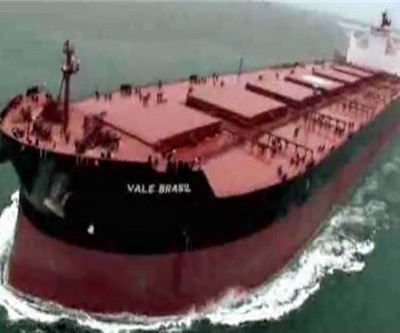
Brazil’s Vale’s first of 35 mega-carriers capable of carrying 400,000 tonnes of dry bulk cargo embarked on its maiden voyage to Dalian, China in May 2011, but the 362-metre-long and 65 metre wide Valemax class which can carry more than twice as much as the next size dry bulk vessel only made it halfway there.
Then Chinese officials egged on by the country’s shipping firms and steel industry decided to ban the giant vessels – 30 of which have been christened – from the country’s ports over fears of the impact on supply and prices.
Despite the fact that most of the carriers were built by Chinese shipyards and financed by the country’s development bank, as part of a massive restructuring China’s ports authority earlier in February set the maximum capacity of ships allowed to berth at 250,000 deadweight tonnes, effectively extending the ban on the Valemax class, indefinitely.
Although its Valemax fleet is calling on ports in Japan, South Korea, Italy and elsewhere, Vale has been forced to use transit centres in Africa and a distribution facility in the Philippines to bring ore to its customers in China because of the ban.
The Brazilian giant is also building a transshipment facility in Malaysia to service the region and João Mendes de Faria, President of Vale China, told a Metal Bulletin conference that the Malaysian center will receive its first Valemax iron ore carrier next month:
“With Malaysia and our floating stations, our logistic strategy over the short and medium term has been settled,” he said, reports reports The Maritime Executive.
A Valemax managed to dock at China’s Lianyungang port in April last year and two ports under construction in China would be able to accommodate the vessels, the predominance of much smaller Capesize vessels, that carries 80% of the world’s iron ore, won’t be challenged soon.
The full Valemax fleet would be able to haul about 44 million tonnes a year to China, which consumes more than two-thirds of the world’s 1.2 billion tonne seaborne iron ore trade.
Rio de Janeiro-based Vale first decided on the VLOC (very large ore carrier) strategy to help it compete with BHP Billiton, Rio Tinto and Fortescue Metals.
Vale plans to up its production by as much as 50% before the end of the decade to 450 million tonnes per year, but is losing market share to its Australian rivals which enjoy much shorter and cheaper routes to Chinese ports.
Image by Fred Vloo of Valemax Rio de Janeiro from YouTube.